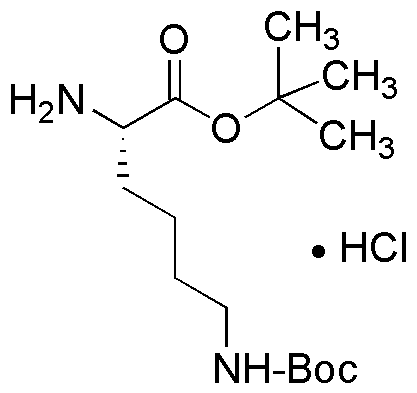Ne-Boc-L-lysine tert-butyl ester hydrochloride is widely utilized in research focused on:
- Peptide Synthesis: This compound serves as a protected amino acid in the synthesis of peptides, allowing for the selective introduction of lysine residues while preventing unwanted reactions.
- Drug Development: It plays a crucial role in the design of pharmaceutical compounds, particularly in creating prodrugs that enhance bioavailability and reduce side effects.
- Bioconjugation: The tert-butyl ester group facilitates the conjugation of biomolecules, aiding in the development of targeted drug delivery systems and diagnostic agents.
- Protein Engineering: Researchers use it to modify proteins, enhancing their stability and functionality, which is essential in therapeutic applications.
- Research in Molecular Biology: It is employed in various molecular biology techniques, including the study of protein interactions and functions, providing insights into cellular processes.
Informations générales
Propriétés
Sécurité et réglementation
Applications
Ne-Boc-L-lysine tert-butyl ester hydrochloride is widely utilized in research focused on:
- Peptide Synthesis: This compound serves as a protected amino acid in the synthesis of peptides, allowing for the selective introduction of lysine residues while preventing unwanted reactions.
- Drug Development: It plays a crucial role in the design of pharmaceutical compounds, particularly in creating prodrugs that enhance bioavailability and reduce side effects.
- Bioconjugation: The tert-butyl ester group facilitates the conjugation of biomolecules, aiding in the development of targeted drug delivery systems and diagnostic agents.
- Protein Engineering: Researchers use it to modify proteins, enhancing their stability and functionality, which is essential in therapeutic applications.
- Research in Molecular Biology: It is employed in various molecular biology techniques, including the study of protein interactions and functions, providing insights into cellular processes.
Documents
Fiches de données de sécurité (FDS)
La FDS fournit des informations de sécurité complètes sur la manipulation, le stockage et l’élimination du produit.
Spécifications du produit (PS)
Le PS fournit une description complète des propriétés du produit, notamment sa composition chimique, son état physique, sa pureté et les exigences de stockage. Il détaille également les plages de qualité acceptables et les applications prévues du produit.
Certificats d'analyse (COA)
Recherchez des certificats d'analyse (COA) en saisissant le numéro de lot du produit. Les numéros de lot et de lot se trouvent sur l'étiquette d'un produit, après les mots « Lot » ou « Lot de fabrication ».
Numéro de catalogue
Numéro de lot/série
Certificats d'origine (COO)
Ce certificat d'exploitation confirme le pays dans lequel le produit a été fabriqué, et détaille également les matériaux et composants utilisés et s'il est issu de sources naturelles, synthétiques ou autres sources spécifiques. Ce certificat peut être requis pour les douanes, le commerce et la conformité réglementaire.
Numéro de catalogue
Numéro de lot/série
Fiches de données de sécurité (FDS)
La FDS fournit des informations de sécurité complètes sur la manipulation, le stockage et l’élimination du produit.
DownloadSpécifications du produit (PS)
Le PS fournit une description complète des propriétés du produit, notamment sa composition chimique, son état physique, sa pureté et les exigences de stockage. Il détaille également les plages de qualité acceptables et les applications prévues du produit.
DownloadCertificats d'analyse (COA)
Recherchez des certificats d'analyse (COA) en saisissant le numéro de lot du produit. Les numéros de lot et de lot se trouvent sur l'étiquette d'un produit, après les mots « Lot » ou « Lot de fabrication ».
Numéro de catalogue
Numéro de lot/série
Certificats d'origine (COO)
Ce certificat d'exploitation confirme le pays dans lequel le produit a été fabriqué, et détaille également les matériaux et composants utilisés et s'il est issu de sources naturelles, synthétiques ou autres sources spécifiques. Ce certificat peut être requis pour les douanes, le commerce et la conformité réglementaire.


